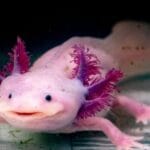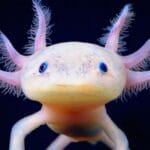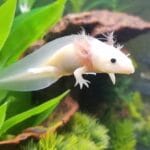Picture this: a creature that can regenerate its own body parts, lives underwater, and has a mischievous grin. Welcome to the captivating world of axolotls! These amazing amphibians have captured the hearts of scientists and nature lovers for years, and we’re here to spill the beans on all their incredible secrets. Get ready to dive into the wonderful world of axolotls!
10 Facts About Axolotls: These Quirky Critters Will Blow Your Mind
We’re diving deep into the world of axolotls – those adorable aquatic salamanders with a permanent “smile” plastered on their faces. Get ready to have your mind blown because these creatures are straight out of a sci-fi movie (but totally real, we promise).
- Regeneration Superstars: Imagine losing a limb and just… growing a new one. That’s everyday life for an axolotl! They can regenerate limbs, tails, spinal cord sections, parts of their heart, and even bits of their brain! Scientists are studying them like crazy, hoping to unlock the secrets of regeneration to help humans one day.
- Forever Young: Axolotls are like the Peter Pan of the amphibian world. They stay in their youthful, larval stage their whole lives, a phenomenon called neoteny. This means they keep their cute, feathery gills and stay water-bound, unlike their salamander cousins who transform and head to land. Why change when you’re already perfect, right?
- Breathing Like a Boss: Speaking of gills, axolotls have a three-part system for getting their oxygen. They can absorb it through those awesome gills, their skin, and their lungs. Talk about having options! This makes them adaptable to different environments, although they prefer the cozy stillness of lake bottoms.
- Social Butterflies (with a Pecking Order): You might think these peaceful-looking creatures would be all about sharing, but they actually have their own little social hierarchies. They use subtle cues to establish dominance, figuring out who gets first dibs on food and the best hiding spots.
- Endangered and Adorable: Sadly, these fascinating creatures are critically endangered in the wild. Habitat loss, pollution, and the introduction of invasive species have taken a toll on their populations. But there’s hope! Conservationists are working tirelessly to save axolotls from extinction. Captive breeding programs and habitat restoration efforts are underway, but everyone can play a part. By supporting responsible breeders and learning about these amazing creatures, we can help ensure their survival.
- The Neoteny Advantage: Remember how we talked about axolotls staying in their juvenile form? Well, it turns out that’s a brilliant evolutionary strategy! By not undergoing metamorphosis, they’re perfectly adapted to their watery homes and can reproduce more efficiently. Talk about making the most of a good thing!
- Medical Marvels: Axolotls aren’t just cool to look at; they hold immense promise for medical breakthroughs. Their crazy regenerative abilities have inspired research into tissue engineering, wound healing, and even organ regeneration.
- Mythical Creatures: Axolotls have captivated humans for centuries. In Aztec mythology, they were linked to the god Xolotl, a transformative trickster often depicted as a dog-headed man. These legends highlight the axolotl’s unique appearance and ability to change form (well, regenerate at least!).
- A Glimmer of Hope: Despite the challenges they face, there’s a glimmer of hope for axolotls. Dedicated scientists and conservationists are working hard to protect these unique creatures and their fragile habitat.
- Ambassadors of the Animal World: With their big smiles and even bigger regenerative powers, axolotls have stolen our hearts and become icons of conservation. They remind us of the incredible diversity of life on Earth and the importance of protecting it. So next time you see an axolotl, take a moment to appreciate its wonder and spread the word about these amazing amphibians!
What are 5 interesting facts about axolotls?
So, we’ve already covered some basics about axolotls, but trust me, there are plenty more mind-blowing facts about these guys. Hold on to your hats because we’re diving deeper into the incredible world of axolotls!
- They’re basically the Wolverine of the animal kingdom. Okay, maybe not exactly, but axolotls have this almost magical ability to regrow lost body parts. We’re not just talking about a tail here – they can regenerate limbs, spinal cord sections, parts of their heart and brain – it’s seriously impressive! This “superpower” makes them super intriguing for scientists hoping to unlock the secrets of tissue regeneration in humans.
- Forever young? Axolotls might have the answer! Unlike their salamander cousins who transform into land-dwelling adults, axolotls prefer to stay in their youthful, water-breathing form for their entire lives. Scientists call this phenomenon “neoteny.” It’s like they’ve figured out the secret to eternal youth! Why they do this is still somewhat of a mystery, but some experts believe it might have something to do with the stable, food-rich environment of their natural habitat.
- Sadly, these amazing creatures are in trouble. Despite their incredible regenerative abilities, axolotls haven’t been able to regenerate their populations in the wild. Sadly, they’re critically endangered due to habitat loss and pollution. The canals and lakes they once called home in Mexico City are now polluted and shrinking, making it harder and harder for these unique creatures to thrive.
- Ancient civilizations were fascinated by them too! The Aztecs were so captivated by the axolotl’s unique appearance and abilities that they even incorporated it into their mythology. They believed the axolotl was a representation of Xolotl, the god of fire, lightning, deformities, and death. Talk about a powerful symbol!
- They could hold the key to medical breakthroughs. You already know about their regeneration thing, right? Well, scientists are super interested in studying this ability because it could have huge implications for human medicine. Imagine being able to regrow damaged tissues and organs – it sounds like something out of science fiction, but axolotls suggest it might be possible! Research is ongoing, and who knows what other secrets these amazing amphibians might hold!
Do axolotls have teeth?
You might think that all those underwater creatures need a good set of chompers, right? Well, axolotls like to keep things interesting. They’re not about that bitey life. Instead of traditional teeth, they’ve got these cool things called tooth plates or cusps inside their mouths. Imagine teeny, tiny plates lining their jaws.
Now, you might be wondering, how in the world do they eat without teeth? Here’s the scoop: axolotls are masters of the suction game. They open their mouths super fast, creating a powerful vacuum that sucks their food right in. Think of it like a straw, but way cooler and much faster. This method works like a charm for their diet of soft-bodied critters like worms and insect larvae, which they gulp down whole.
Why are axolotls like this? It all goes back to their neotenous nature. Basically, they stay in a kind of perpetual childhood state. While most amphibians grow up and change completely (think tadpoles turning into frogs), axolotls decided they liked the youthful glow and never fully transition into adults. This means they keep their gills and, you guessed it, never develop a full set of teeth.
Scientists are still trying to piece together the whole picture of axolotl evolution. By studying their unique characteristics, we can learn so much about how these creatures have adapted over time. It really makes you appreciate the incredible diversity of life, even in something as seemingly simple as teeth (or the lack thereof!).
So, there you have it! Axolotls may not have the pearly whites you’d expect, but they’ve got their own amazing way of navigating the underwater world.
Do Axolotls Have 5 Fingers?
So, we’ve been talking about axolotls and their really cool features, but let’s clear up something about their little hands – or should we say, toes? It’s easy to think they have five fingers like us, but it turns out that’s not quite right!
They don’t actually have fingers at all. Instead of those five-fingered hands we’re used to, they’ve got these specialized toes. These toes aren’t just for show, though. They’re built perfectly for their life underwater. Think about it: they use their toes to swim around, grab onto things, and even catch their meals! Pretty neat, right?
These toes, along with their awesome webbed tail, make axolotls super skilled swimmers and help them move smoothly through the water. So, while they may not be high-fiving anytime soon, their unique toes are a key part of what makes them so fascinating!
Do axolotls have 4 fingers?
You bet they do! Axolotls sport four fingers on each front foot, and get this – they’re totally webbed. It’s like having built-in swim gloves! This unusual feature is a key part of what makes these creatures such awesome swimmers and helps them navigate their watery homes.
Now, you might be thinking, “Four fingers? That’s kinda weird.” And you’d be right, at least when we compare them to other salamanders. Many of their salamander cousins have five fingers on their front feet. So why the difference?
Well, scientists are still trying to unravel all the mysteries of axolotl development, but it likely comes down to their lifestyle. You see, axolotls never really grow up in the same way that other salamanders do. They stay in their youthful, aquatic form their whole lives – a phenomenon scientists call “neoteny.” It’s like they’ve figured out the fountain of youth, at least in terms of their bodies!
This unique life cycle, coupled with their distinctive four-fingered hands, makes axolotls a goldmine for scientific research. By studying these quirky amphibians, researchers can learn a lot about limb development, regeneration, and even the genetic mechanisms that control these processes. So, while those four little fingers might seem like a small detail, they hold big clues to some of biology’s biggest questions!
How many hearts do axolotls have?
So, we’ve talked about some of the cool things about axolotls, but let’s dive into something truly fascinating: their heart! Now, you might think all creatures as complex as axolotls would have a heart similar to ours. Well, get this: axolotls have a three-chambered heart. That’s right, three! We humans, on the other hand, have a four-chambered heart.
Now, you might wonder how a three-chambered heart can possibly be effective. It seems almost counterintuitive, right? But here’s the thing: the axolotl’s heart has evolved to perfectly suit its needs. It efficiently pumps blood, ensuring that oxygen gets delivered throughout its body without a hitch.
Think of it like this: different animals have different evolutionary paths, leading to unique adaptations. The three-chambered heart of an axolotl is a perfect example of this, a testament to the incredible diversity of life and the amazing ways creatures adapt to their environments. While we are still unraveling all the mysteries surrounding the axolotl’s heart, one thing is clear: it’s a powerful pump that keeps these amazing creatures thriving!
Can axolotls smile?
So, you’re curious about whether our underwater buddies, the axolotls, can flash us a grin? You’re not alone! It’s a question that pops up a lot, and the answer is surprisingly tricky. You see, axolotls do seem to sport a perpetual smile, but it’s not quite the same as what we humans do.
Think of it this way: their faces are naturally structured in a way that mimics a smile. They’ve got these wide mouths that curve upwards at the edges, making it look like they’re permanently amused. This distinctive feature is all thanks to a couple of strong muscles that run along their jawline, helping them open and close their mouths for all those yummy worm snacks!
Now, here’s the catch – while their “smiles” might make us think they’re happy, it’s not really an expression of emotion like it is for us. Unlike humans, axolotls don’t have the same complex set of facial muscles that allow for a whole range of expressions. They can’t really control their “smile” or use it to communicate feelings.
But hey, just because they might not be grinning with joy doesn’t make them any less amazing! These little guys are still incredibly cool creatures. I mean, have you heard about their superpower? Axolotls have this incredible ability to regenerate limbs, and even parts of their organs! Talk about being built differently!
Scientists are still unraveling all the mysteries surrounding axolotls and their regenerative prowess. There’s ongoing research into how they do it, and what we can learn from them. It’s a fascinating field with the potential for incredible breakthroughs in medicine and beyond!
So, the next time you see a picture of an axolotl with that adorable “smile,” remember that while it might not be a conscious expression of happiness, it’s still a testament to the unique and fascinating nature of these underwater wonders. They might do things differently than us, but that’s what makes them so captivating, right?
How fast can axolotls swim?
So, we’ve talked about how axolotls move around, but how fast can these little guys actually go? Well, they’re not going to be winning any races against your average fish. Think more of a leisurely stroll through the water than an Olympic sprint!
On average, axolotls cruise at a speed of about 0.6 to 1.2 miles per hour. This slower pace is partly because, unlike many fish, they don’t have a swim bladder – that gas-filled sac that helps with buoyancy and maneuverability. Instead, they rely on their powerful tails and those cute little webbed feet to propel themselves through the water.
Now, don’t let their usual chill vibe fool you. When hunger strikes and a tasty worm or insect swims by, axolotls can unleash a surprising burst of speed. It’s like a sudden switch flips, transforming them into miniature, underwater hunters.
But speed isn’t everything in the animal kingdom, right? Axolotls make up for what they lack in raw speed with their incredible agility. They can twist, turn, and navigate their surroundings with impressive grace.
While researchers continue to learn more about these captivating creatures, one thing is clear: their unique adaptations and fascinating behaviors make them a joy to observe and study.
Why are axolotls pink?
So, we’ve talked about how axolotls come in a bunch of different colors, right? But let’s be real, the classic axolotl look is that bubblegum pink. It’s like their trademark! But have you ever wondered why so many of them rock that rosy hue?
Turns out, it’s mostly down to their genes. You know how some folks have brown hair and others have blonde? It’s the same kind of deal. Axolotls have this gene that’s supposed to tell their bodies to make melanin, which is the stuff that gives skin its color. But a lot of them inherit a version of this gene that doesn’t quite work the way it should. It’s like a broken recipe for melanin! And without enough melanin, they end up looking pretty in pink.
But here’s where it gets even cooler: an axolotl’s diet can actually play a part too! Think about it like this: when you eat a lot of carrots, your skin can get a bit orange-ish, right? That’s because of the carotene in carrots. Well, axolotls get something similar from their food. If they eat a lot of stuff that’s high in carotenoids (which are like natural pigments found in plants and animals), their skin can take on a pinker tone.
And hold on, there’s more! Even the water they live in can affect their color a bit. If the water has a lot of certain minerals in it – think iron, for example – it can make an axolotl’s skin look darker.
So, it’s not just one thing that makes axolotls pink. It’s this whole combination of their genes, what they eat, and even the environment they live in! Scientists are still trying to figure out all the details, but isn’t it wild how much goes into something as simple as an animal’s color?
How many years do axolotls live?
So, you’re curious about how long these amazing creatures, axolotls, actually live? Well, it’s a bit like comparing apples and oranges depending on whether they’re swimming in the wild or chilling in a tank.
Think about it: life in the wild is tough. It’s a constant battle for survival with predators lurking around every corner and not always enough food to go around. For axolotls in their natural habitat, this means they’re lucky if they make it to 5–10 years old.
Now, picture life in a comfy aquarium. No predators, a constant supply of yummy food, and regular water changes to keep things nice and clean. Sounds pretty sweet, right? That’s why axolotls living the good life in captivity can often reach a ripe old age of 10–15 years, sometimes even older! It’s amazing how much a stress-free environment can influence their lifespan.
While their ability to regenerate limbs is seriously cool, it’s important to remember that axolotls aren’t immortal. The more we learn about what impacts their lifespan, the better we can protect these fascinating creatures, both in the wild and in our care.
How many axolotls are left exactly?
We know axolotls are in trouble, but putting an exact number on how many are left in the wild is really tough. It’s like trying to count bubbles in a lake! What we do know is that their numbers have taken a HUGE hit, and it’s really worrying.
Think about it: these amazing creatures used to be all over Lake Xochimilco in Mexico. Now, experts think there could be as few as 700 to maybe 1,200 individuals trying to survive out there. That’s a tiny number compared to what it used to be.
Why are their numbers so low? Well, it’s like their home is being squeezed smaller and smaller. Pollution is a major problem, making the water a dangerous place for them to live. And sadly, sometimes axolotls even end up hybridizing with other salamander species, which further muddies the genetic waters, so to speak.
The good news is that lots of people are working hard to help axolotls. There are breeding programs trying to raise healthy axolotls, and scientists are constantly learning more about how to protect them. But it’s a big challenge, and we still have a lot to learn about these incredible creatures.
Did you know that orangutans have unique personalities? Discover more fascinating facts about those amazing creatures here: 10 fun facts about orangutans.
Unveil the fascinating world of rattlesnakes – from their venomous bites to their remarkable hunting strategies – in this comprehensive article: 10 interesting facts about rattlesnakes.
Prepare to be amazed by the colossal size and captivating behavior of hippos. Dive into 20 intriguing facts that will ignite your curiosity: 20 fun facts about hippos.









